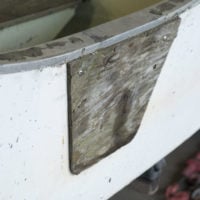What wood do folks recommend when replacing the wood mounting plate on exterior side of the transom, and what kind of preparation is required? This is in an old Alumacraft 14-footer. The transom board is solid and dry, but the exterior plate is in tough shape. It’s not a picture of my specific boat, but the attached shows what I’m talking about in general.
For hardware do I just want stainless steel? I’m planning to thru-bolt and will use 5200 to seal around all bolt holes.
Thanks!
